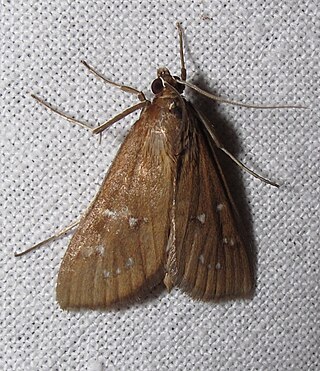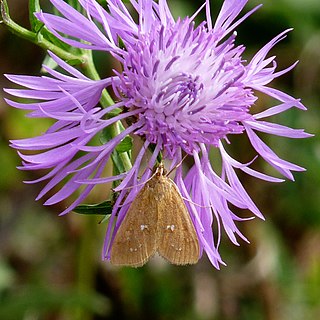
Diastictis is a genus of moths of the family Crambidae.

Diastictis ventralis, the white-spotted brown moth, is a moth of the family Crambidae. It is found in eastern North America.
Elophila atlantica is a moth in the family Crambidae. It was described by Eugene G. Munroe in 1972. It is found on North America, where it has been recorded from Nova Scotia, Florida, Maine, Maryland and South Carolina.
Orenaia pallidivittalis is a moth in the family Crambidae. It was described by Eugene G. Munroe in 1956. It is found in North America, where it has been recorded from British Columbia.
Lipocosma septa, the exposed lipocosma moth, is a moth in the family Crambidae. It was described by Eugene G. Munroe in 1972. It is found in North America, where it has been recorded from Florida, Georgia, Maryland, North Carolina, Oklahoma, South Carolina, Texas and Virginia.
Loxostege sierralis is a moth in the family Crambidae. It was described by Eugene G. Munroe in 1976. It is found in North America, where it has been recorded from British Columbia, Saskatchewan, Washington, Utah, Oregon and California.
Cosipara modulalis is a moth in the family Crambidae. It was described by Eugene G. Munroe in 1972. It is found in North America, where it has been recorded from Arizona and Colorado.
Scoparia apachealis is a moth in the family Crambidae. It was described by Eugene G. Munroe in 1972. It is found in North America, where it has been recorded from Arizona, New Mexico and Utah.
Frechinia texanalis is a moth in the family Crambidae. It was described by Eugene G. Munroe in 1961. It is found in North America, where it has been recorded from Texas.
Noctueliopsis atascaderalis is a moth in the family Crambidae. It was described by Eugene G. Munroe in 1951. It is found in North America, where it has been recorded from California.
Diastictis albovittalis is a moth in the family Crambidae. It was described by Eugene G. Munroe in 1956. It is found in Puebla, Mexico.
Diastictis holguinalis is a moth in the family Crambidae. It was described by Eugene G. Munroe in 1956. It is found in Cuba and Florida.
Diastictis pseudargyralis is a moth in the family Crambidae. It was described by Eugene G. Munroe in 1956. It is found in North America, where it has been recorded from Florida, South Carolina and West Virginia.

Diastictis sperryorum is a species of moth in the family Crambidae. It was described by the Canadian entomologist Eugene Munroe in 1956.
Diastictis viridescens is a moth in the family Crambidae. It was described by Eugene G. Munroe in 1956. It is found in North America, where it has been recorded from Arizona.

Diastictis argyralis, the white-spotted orange moth, is a moth in the family Crambidae. It was described by Jacob Hübner in 1818. It is found in North America, where it has been recorded from Colorado, Florida, Georgia, Indiana, Maine, Maryland, Mississippi, North Carolina, Ohio, Ontario, South Carolina, Tennessee, Texas and Virginia.
Palpita kimballi, or Kimball's palpita moth, is a moth in the family Crambidae. It was described by Eugene G. Munroe in 1959. It is found in North America, where it has been recorded from Alabama, Florida, Georgia, Louisiana, North Carolina, Oklahoma, South Carolina, Tennessee and Virginia.
Udea abstrusa is a moth in the family Crambidae. It was described by Eugene G. Munroe in 1966. It is found in North America, where it has been recorded from Alberta, British Columbia, Colorado, New Mexico, the Northwest Territory, Washington and Wyoming.
Udea brevipalpis is a moth in the family Crambidae. It was described by Eugene G. Munroe in 1966. It is found in North America, where it has been recorded from California, Colorado and Utah.
Udea cacuminicola is a moth in the family Crambidae. It was described by Eugene G. Munroe in 1966. It is found in North America, where it has been recorded from Colorado and Wyoming.




